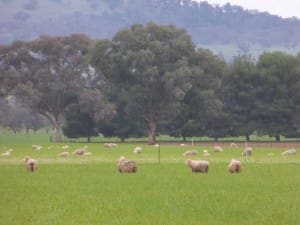LAMBING ewes can safely graze on dual purpose wheat and avoid metabolic disease, new research by Charles Sturt University in southern New South Wales has shown.
Research by CSU whole farm management lecturer Dr Shawn McGrath, established that good livestock management, including the supply of mineral supplements and having ewes in good condition, could help reduce or prevent metabolic disease.
Dr Shawn McGrath is a lecturer in whole farm management in the School of Animal and Veterinary Sciences at CSU in Wagga Wagga. His PhD involved surveys, and field trials grazing late-pregnant and lambing ewes on dual-purpose wheat.
Dual purpose wheat refers to crops that are sown earlier than usual with the aim of grazing livestock on crops during the vegetative phase prior to stem elongation to managing a winter feed gap and allow farmers to increase stocking rates. Livestock are then removed from the crop so that grain can be harvested at the end of the season.
Dr McGrath said his research supported the hypothesis that grazing lambing ewes on dual-purpose wheat provided a strategy to manage the winter feed gap and increase returns for producers.
“Ewes grazing wheat forage during late pregnancy and lactation may be more susceptible to metabolic diseases such as hypomagnesaemia, hypocalcaemia and pregnancy toxaemia.
“This is due to the low calcium, high potassium and low sodium levels in wheat forage, which could result in ewe mortality and lower production,” he said.
“Therefore it is prudent to supply additional calcium, magnesium and sodium to ewes grazing wheat in the form of mineral supplements, and to manage ewes to minimise the risk of these metabolic diseases occurring.”
Dr McGrath has made several recommendations for mixed-farmers in southern NSW considering grazing ewes on dual-purpose wheat to increase the profitability of their sheep enterprise:
– Optimise stocking rates to maximise profitability
– Provide ewes during late-pregnancy and lactation with a loose-lick mineral supplement that includes calcium, magnesium and sodium
– Ensure ewes are in body condition score of ≥ 3 at lambing
– Use moderate stocking rates for ewes during late pregnancy and lambing, particularly if the starting biomass is low.
For more information follows these links to research papers:
http://dx.doi.org/10.1071/AN13179
http://dx.doi.org/10.1071/AN12134
http://dx.doi.org/10.1111/avj.12089
Source: Charles Stuart University.


HAVE YOUR SAY